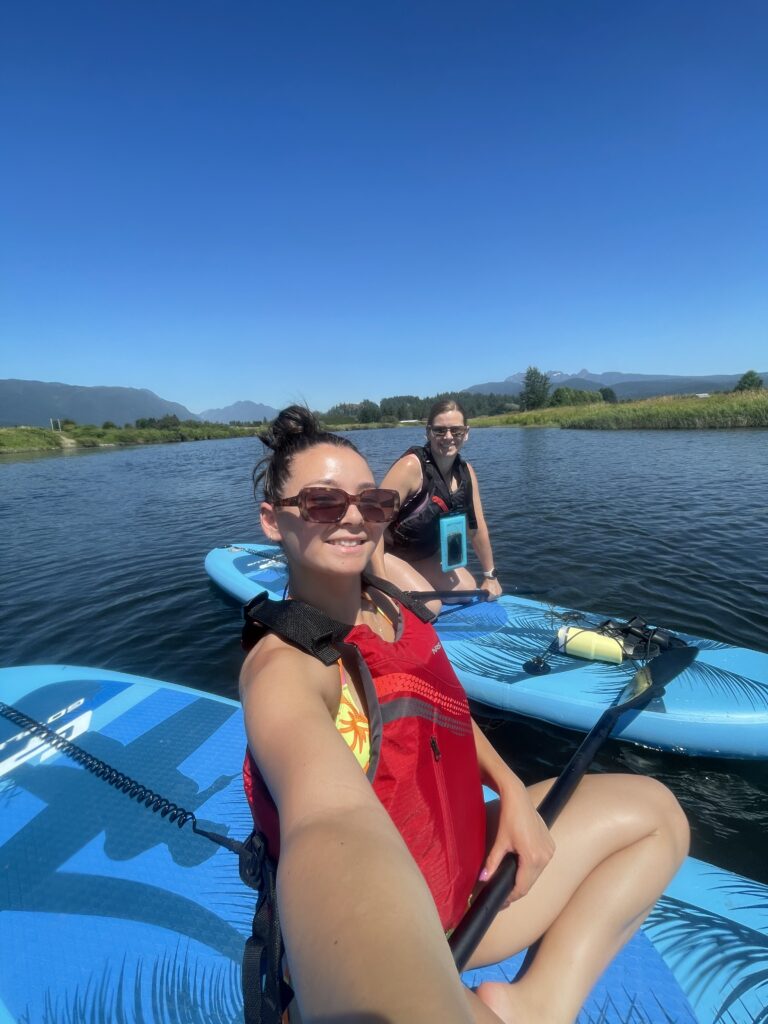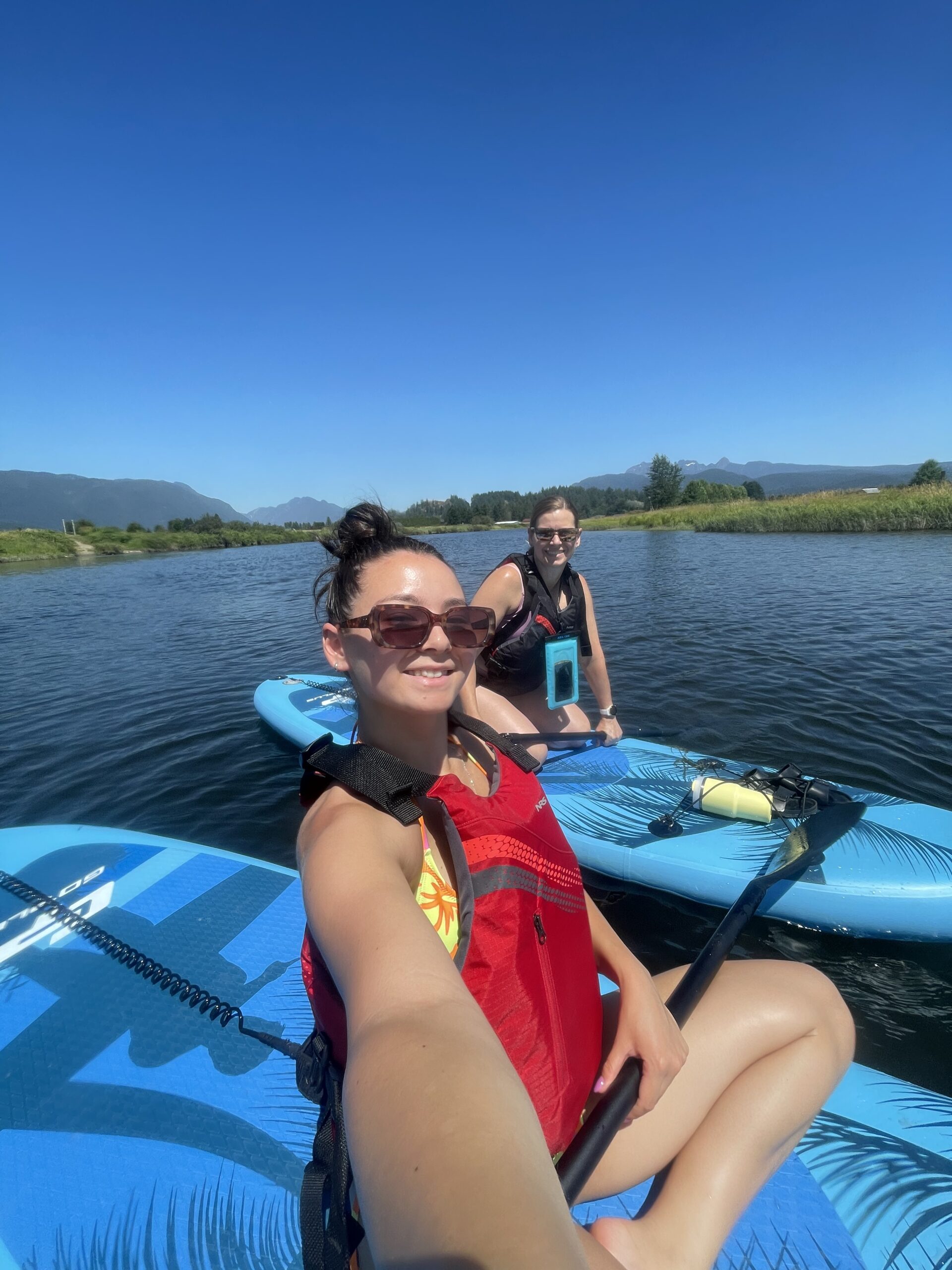
Stand up paddle boarding (SUP) has been gaining in popularity over the past several years. It looks very relaxing and calm (it is), but on your first time out you may be surprised by which muscles are sore the next day (hello, core!). A great way to improve your stand up paddle boarding is by practicing Pilates to improve your strength, balance, and mobility so you can paddle further and longer comfortably.
I Love Paddle Boarding
We tried SUP many years ago in Hawaii and then a few times in Whistler. Last summer we finally went for it and bought our own pair of boards. Honestly, I think the timing was great for us. We’re at a phase in life where grabbing the boards and heading out for a couple of hours at the lake or on the river is easy. Our daughters are also of an age where they can grab the boards and a sister or friend and head out on their own.
Paddle boarding is an easy and fun way to enjoy nature from a different perspective. I find it so relaxing to get out on the water and paddle or even just sit and chill on the board. The sound of the water is calming, there are birds and the odd fish, and I even saw a sea lion a couple weeks ago.
Finding Your Balance
The first time you get on a paddle board can be a bit scary. You’re trying to stand on this wobbly board in the water – yikes! Of course, you can start in shallow water to get more comfortable and you should definitely have a life vest on as you head out to the deeper waters. Whether you decide to sit or stand, balance is essential to paddle boarding.
In the beginning, most people choose to sit or kneel on their paddle board. There are even seat attachments for some if you really want to feel secure, but it’s not necessary. I find that I usually start out kneeling, then stand for a while, and switch to sitting with my feet out in front of me or straddling the board. I will switch to paddle faster in certain positions or to give certain muscles a break.
With all of that switching around, as well as getting on, off, and staying on the board, you need to have good balance. Yes, the activity itself will help better your balance, but Pilates can really improve your stand up paddle boarding in between those trips to the lake.
Try Different Paddling Positions
As I mentioned above, there are several ways you can try paddling. Try kneeling by sitting back on your heels or upright, but be sure to keep a tall spine. Try tucking your toes under or having the top of your foot flat on the board while kneeling. If kneeling isn’t working, try sitting!
Sit up tall, straddle the board and dangle your feet in the water, or sit tall and extend your legs straight out ahead of you. I’ve even seen people sit cross-legged. The legs in the water option will slow you down, though. Having the legs straight out can be difficult for some, especially if you have tight hip flexors, hamstrings, and/or lower back (it’s all related). Again, Pilates can help.
Getting the Board Ready to Go
Even with great balance, yes, there is a chance that you might fall off of the board. Depending on the depth of the water, you may have to pull yourself back up onto it. This is where upper body strength is required, along with your core strength.
Upper body strength is also required before you’re even on the water, as you need to inflate the board and maybe carry it to the water. Hand-pumping your SUP can take a good fifteen minutes of hard work, and you’ll feel it in your arms, back, shoulders, and even your legs. (An electric pump is a great idea, here.)
We like to pump our boards up at the car and carry them to the water. You can always carry the uninflated board in its backpack and pump it up at the beach, but then you either have to leave the pump and accessories on the beach or walk back to the car to lock them up. I had never thought of the logistics of paddle boarding before we got them.
My daughter and friend recently took their boards to a lake but needed to walk down a trail to get to the beach. They opted to carry the pumped-up boards and they said that they had to keep switching the board from one side of their body to the other every few minutes. However you decide to get your board ready and to the water, body and leg strength is needed.
A Cautionary Tale
Here’s a funny story (or not so funny for the man that this happened to) about why you may need to be strong to paddle board. A couple weeks ago my husband and I were out on our SUPs and we passed a woman who kept looking back. She said to us, “Whatever you do, don’t drop your paddle like he did”, and she kept going. We get a little further and we meet up with her partner, who is wearing his flip flops on his hands to help him paddle, laying over the end of his board, and kicking his way (a long way) back to where they parked. He said, “I wish I had spent a little more money and got floating paddles.” So again, upper body and back strength might be needed! Oh, and check if your paddle sinks. (It turns out that ours float, thank goodness!).
Pilates will Improve Your Stand Up Paddle Boarding
Pilates is full body exercise, much like SUP can be. There are also a lot of similar movement types to help you improve your stand up paddle boarding. There are exercises that have you balancing or kneeling on a moving surface (the reformer carriage) or on a sturdy one (like the tower/cadillac or wunda chair). Then some exercises that have you face down like that poor man who lost his paddle, where you are working your back and arms.
In every exercise, your core, legs, butts, arms, back, and even neck are participating in the workout. Little by little, you will work toward the more challenging exercises that require you to have more control and strength. As you practice Pilates more and more it becomes second nature, and the less you have to think about it – just like in paddle boarding!

View comments
+ Leave a comment